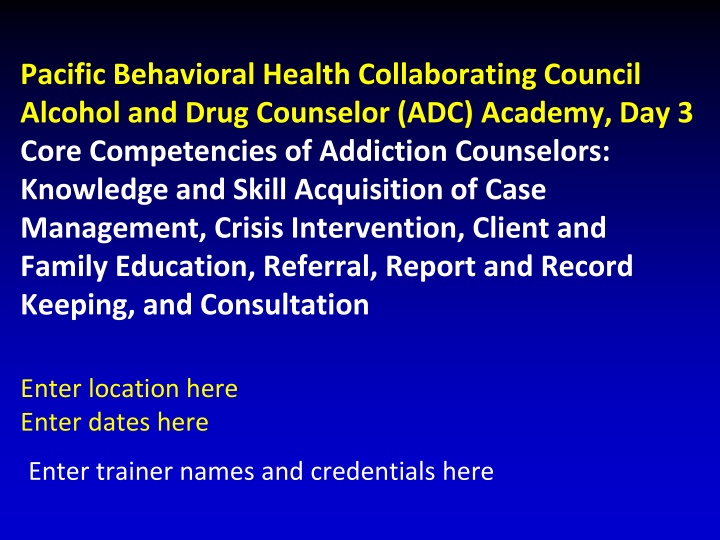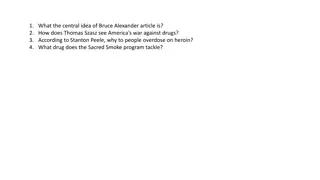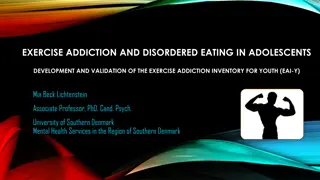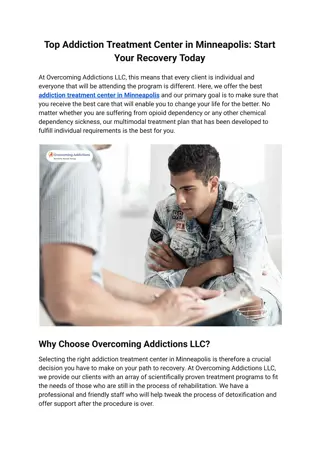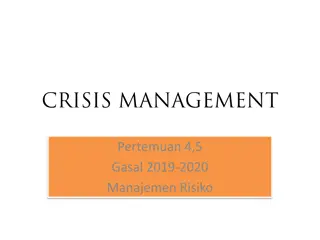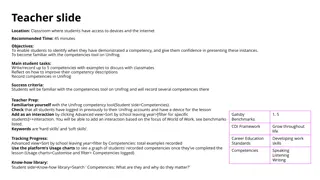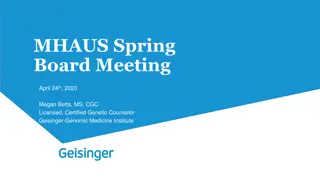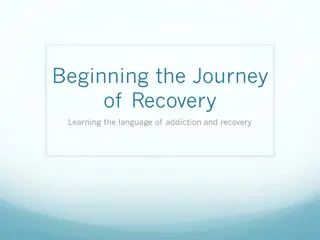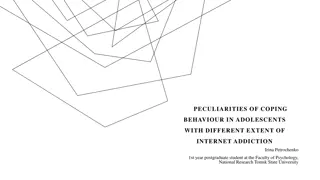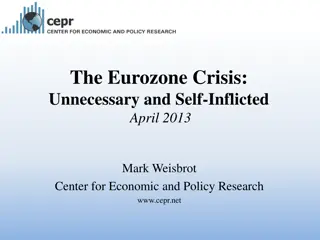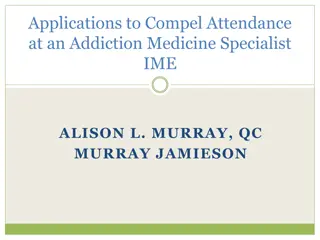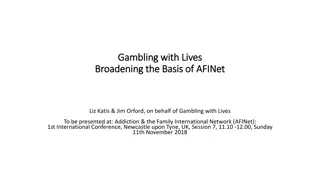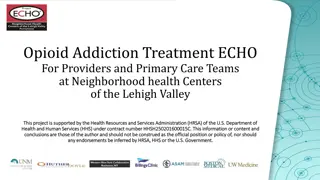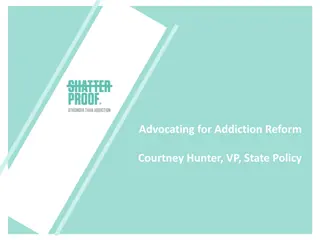Core Competencies of Addiction Counselors: Case Management, Crisis Intervention, Education
This training program focuses on enhancing the knowledge and skill acquisition of alcohol and drug counselors in key areas such as case management, crisis intervention, client and family education, referral processes, report and record keeping, and consultation practices. Developed by experts in the field, this program equips counselors with essential competencies to effectively support individuals facing addiction challenges.
Download Presentation

Please find below an Image/Link to download the presentation.
The content on the website is provided AS IS for your information and personal use only. It may not be sold, licensed, or shared on other websites without obtaining consent from the author.If you encounter any issues during the download, it is possible that the publisher has removed the file from their server.
You are allowed to download the files provided on this website for personal or commercial use, subject to the condition that they are used lawfully. All files are the property of their respective owners.
The content on the website is provided AS IS for your information and personal use only. It may not be sold, licensed, or shared on other websites without obtaining consent from the author.
E N D
Presentation Transcript
Pacific Behavioral Health Collaborating Council Alcohol and Drug Counselor (ADC) Academy, Day 3 Core Competencies of Addiction Counselors: Knowledge and Skill Acquisition of Case Management, Crisis Intervention, Client and Family Education, Referral, Report and Record Keeping, and Consultation Enter location here Enter dates here Enter trainer names and credentials here
Acknowledgements This training was developed by Dr. Thomas E. Freese, PhD (Director of Training of UCLA ISAP and Director of the Pacific Southwest ATTC), Alex R. Ngiraingas, MEd, CSAC II, ICADC, ICPS, and Dr. Christopher C. C. Rocchio, PhD, LCSW, CSAC, ICADC (Clinical Specialist, UCLA) in August of 2018 under contract number 2018-002 by the University of California Los Angeles, Integrated Substance Abuse Programs (UCLA ISAP) and the Pacific Southwest Addiction Technology Center (PSATTC) for the Pacific Behavioral Health Collaborating Council (PBHCC). Additional resource provided by SAMHSA, grant number UR1TI080211. 2
Disclaimer for Training The UCLA, its employees, contractors, and affiliates shall not be liable for any damages, claims, liabilities, costs, or obligations arising from the use or misuse of materials or information contained in this presentation. Any use, copying, or distribution without written permission from the UCLA and the PBHCC is prohibited. 3
Today's Agenda (1) Review and check-in Twelve Core Functions (continued) Case Management Crisis Intervention Client and Family Education Referral Report and Record keeping Consultation 4
Agenda for Case Management Definition Distilling the core elements Core competencies Core functions of case management Core functions of case management across the treatment continuum of care Global Criteria 5
Definition of Case Management The administrative, clinical, and evaluative activities that bring the client, treatment services, community agencies, and other resources together to focus on issues and needs identified in the treatment plan (CSAT, 2006, p.79). "Activities which bring services, agencies, resources, or people together within a planned framework of action toward the achievement of established goals. It may involve liaison activities and collateral contacts (IC&RC, 2013) Reference Center for Substance Abuse Treatment. (2006). Addiction counseling competencies: the knowledge, skills, and attitudes of professional practice. Technical Assistance Publication (TAP) Series 21 (HHS Publication No. (SMA) 15-4171). Rockville, MD: Substance Abuse and Mental Health Services Administration. 6
Definition of Case Management (continued) Case management and the role of case managers is contextually defined. Case management models vary in their focus, purpose, and intensity for different populations. Case management also contingent on the access and availability of different resources, as well as to the client s needs, preferences, and priorities. Reference Center for Substance Abuse Treatment. (2006). Addiction counseling competencies: the knowledge, skills, and attitudes of professional practice. Technical Assistance Publication (TAP) Series 21 (HHS Publication No. (SMA) 15-4171). Rockville, MD: Substance Abuse and Mental Health Services Administration. 7
Distilling the Core Elements of Case Management A set of social service functions that helps clients access a variety of resources, both internal and external. Identify and utilize the client's own strengths. Advocacy is a hallmark of case management. Therapy is focused on intra- and interpersonal change while case management aims to enhance resource acquisition. Reference Center for Substance Abuse Treatment. (2015). Comprehensive Case Management for Substance Abuse Treatment. Treatment Improvement Protocol (TIP) Series 27 (HHS Publication No. (SMA) 15-4215). Rockville, MD: Substance Abuse and Mental Health Services Administration. 8
Core Functions of Case Management Engagement Assessment Planning, goal setting, and implementation Linking, monitoring, and advocating Disengagement Reference Center for Substance Abuse Treatment. (2015). Comprehensive Case Management for Substance Abuse Treatment. Treatment Improvement Protocol (TIP) Series 27 (HHS Publication No. (SMA) 15-4215). Rockville, MD: Substance Abuse and Mental Health Services Administration. 9
Core Functions Across Continuum of Care Continuum of Care for Treating Substance Use Disorders: Pretreatment Treatment Aftercare Core Functions of Case Management: Engagement Assessment Planning, goal setting, and implementation Linking, monitoring, and advocating Disengagement Reference Center for Substance Abuse Treatment. (2015). Comprehensive Case Management for Substance Abuse Treatment. Treatment Improvement Protocol (TIP) Series 27 (HHS Publication No. (SMA) 15-4215). Rockville, MD: Substance Abuse and Mental Health Services Administration. 10
Pre-Treatment and Case Management
Engagement in Pre-Treatment (1) Review meeting agenda. Orient clients to process. Engage individuals using stage-appropriate services. Use motivational interviewing or motivational enhancement approaches. What are the stages of change? Reference Center for Substance Abuse Treatment. (2015). Comprehensive Case Management for Substance Abuse Treatment. Treatment Improvement Protocol (TIP) Series 27 (HHS Publication No. (SMA) 15-4215). Rockville, MD: Substance Abuse and Mental Health Services Administration. 12
Stages of Change Precontemplation Client is unaware or under-aware of the problem. Client has not intention to change. Contemplation Aware that a problem exists. Considering change. No commitment. Weighing pros and cons. Reference Center for Substance Abuse Treatment (2013). Enhancing motivation for change in substance abuse treatment. Treatment Improvement Protocol (TIP) Series 35 [ HHS Publication No. (SMA) 13-4212]. Rockville, MD: Substance Abuse and Mental Health Services Administration, Substance Abuse Mental Health Services Administration. (2015). Substance abuse treatment for persons with co- occurring disorders. Treatment Improvement Protocol (TIP) Series 42 (HHS Publication No. (SMA) 13-3992). Rockville, MD: Substance Abuse and Mental Health Services Administration. 13
Stages of Change (continued) Preparation Ready to change. Action planned in foreseeable future. Action Modify behavior, experiences, ands/or environment to overcome a specific problem. Maintenance Prevent relapse. Sustains the change beyond 6 months. Reference Substance Abuse Mental Health Services Administration. (2015). Substance abuse treatment for persons with co- occurring disorders. Treatment Improvement Protocol (TIP) Series 42 (HHS Publication No. (SMA) 13-3992). Rockville, MD: Substance Abuse and Mental Health Services Administration. 14
Engagement in Pre-Treatment (2) Assist the client with meeting basic survival needs. Coordinate referrals. Provide basic education about substance use disorders and recovery. Facilitate conversations that remind or help the client gain insight into past and future consequences of continued substance use. Orient and educate clients to program requirements and review potential consequences (if known) of nonadherence. Reference Center for Substance Abuse Treatment. (2015). Comprehensive Case Management for Substance Abuse Treatment. Treatment Improvement Protocol (TIP) Series 27 (HHS Publication No. (SMA) 15-4215). Rockville, MD: Substance Abuse and Mental Health Services Administration. 15
Assessment in Pre-Treatment Prescreen and assess for program eligibility refer to external provider if not eligible. Assess for specific skill deficits, level of functioning, basic support needs, and risk status. Identify strengths, needs, desires, and deficits. Assess for harm to self or others. Reference Center for Substance Abuse Treatment. (2015). Comprehensive Case Management for Substance Abuse Treatment. Treatment Improvement Protocol (TIP) Series 27 (HHS Publication No. (SMA) 15-4215). Rockville, MD: Substance Abuse and Mental Health Services Administration. 16
Assessment: Use of a Decisional Balance Decisional balance exercise What are the good things about...? What are the not-so-good things about...? What are the not-so-good things about changing? What are the good things about changing? Reference Center for Substance Abuse Treatment. (2015). Comprehensive Case Management for Substance Abuse Treatment. Treatment Improvement Protocol (TIP) Series 27 (HHS Publication No. (SMA) 15-4215). Rockville, MD: Substance Abuse and Mental Health Services Administration. 17
Planning, Goal Setting, Implementation (1) Focus on immediate needs and entry into SUD treatment. Negotiate and work on agreed upon goals, especially if the client is actively using. Coordinate multiple service plans. Reference Center for Substance Abuse Treatment. (2015). Comprehensive Case Management for Substance Abuse Treatment. Treatment Improvement Protocol (TIP) Series 27 (HHS Publication No. (SMA) 15-4215). Rockville, MD: Substance Abuse and Mental Health Services Administration. 18
Linking, Monitoring, and Advocating (1) Enhance the client s commitment to contacting the potential provider or resource. Identify and problem solve potential obstacles and barriers. Outline next steps create a plan for establishing and maintaining contact. Model and rehearse the plan. Reference Center for Substance Abuse Treatment. (2015). Comprehensive Case Management for Substance Abuse Treatment. Treatment Improvement Protocol (TIP) Series 27 (HHS Publication No. (SMA) 15-4215). Rockville, MD: Substance Abuse and Mental Health Services Administration. 19
Disengagement in Pre-Treatment Disengagement is a process that should be planned and deliberate. Emphasis on client involvement, investment, and participation in service planning. Assess for suicidal ideation, harm to self and/or others. Reference Center for Substance Abuse Treatment. (2015). Comprehensive Case Management for Substance Abuse Treatment. Treatment Improvement Protocol (TIP) Series 27 (HHS Publication No. (SMA) 15-4215). Rockville, MD: Substance Abuse and Mental Health Services Administration. 20
Engagement in Treatment Orient client to program rules and requirements. Elicit client expectations. Address immediate concerns to ensure client s focus remains on addressing their substance use disorder. Assess for suicidal ideation, harm to self and/or others. Reference Center for Substance Abuse Treatment. (2015). Comprehensive Case Management for Substance Abuse Treatment. Treatment Improvement Protocol (TIP) Series 27 (HHS Publication No. (SMA) 15-4215). Rockville, MD: Substance Abuse and Mental Health Services Administration. 22
Assessment in Treatment Assess functional skills deficits and strengths Service procurement skills Pre-vocational and vocation-related skills Assess for suicidal ideation, harm to self and/or others Reference Center for Substance Abuse Treatment. (2015). Comprehensive Case Management for Substance Abuse Treatment. Treatment Improvement Protocol (TIP) Series 27 (HHS Publication No. (SMA) 15-4215). Rockville, MD: Substance Abuse and Mental Health Services Administration. 23
Planning, Goal Setting, Implementation (2) Develop individualized person-centered service plans. Provide ongoing motivation. Remind clients of potential consequences. Coordinate service plans. Coordinate interventions among various providers. Facilitate acquisition of basic survival needs. Coordinate transitions between programs. Respond to relapses. Support clients with activating crisis plans. Reference Center for Substance Abuse Treatment. (2015). Comprehensive Case Management for Substance Abuse Treatment. Treatment Improvement Protocol (TIP) Series 27 (HHS Publication No. (SMA) 15-4215). Rockville, MD: Substance Abuse and Mental Health Services Administration. 24
Linking, Monitoring, and Advocating (2) Monitor client progress and adjust service plans. Advocate for clients to support them in achieving goals established in the service plan. Reference Center for Substance Abuse Treatment. (2015). Comprehensive Case Management for Substance Abuse Treatment. Treatment Improvement Protocol (TIP) Series 27 (HHS Publication No. (SMA) 15-4215). Rockville, MD: Substance Abuse and Mental Health Services Administration. 25
Disengagement in Treatment Disengagement is a process that should be planned and deliberate. Facilitate discussion and reinforce what clients have learned. Review and summarize client progress. Emphasize client strengths. Reference Center for Substance Abuse Treatment. (2015). Comprehensive Case Management for Substance Abuse Treatment. Treatment Improvement Protocol (TIP) Series 27 (HHS Publication No. (SMA) 15-4215). Rockville, MD: Substance Abuse and Mental Health Services Administration. Rapp, C.A. & Goscha, R. J. (2006). The strengths model: case management for people with psychiatric disabilities (2nd ed.). New York, NY: University Press. 26
Engagement in Aftercare Ensure continuity between providers and among different resources. Address needs, including but not limited to: housing, healthcare, income, education and/or employment, and social supports. Reference Center for Substance Abuse Treatment. (2015). Comprehensive Case Management for Substance Abuse Treatment. Treatment Improvement Protocol (TIP) Series 27 (HHS Publication No. (SMA) 15-4215). Rockville, MD: Substance Abuse and Mental Health Services Administration. 28
Assessment Assess readiness for reintegration into the community throughout the treatment continuum. Support clients with identifying relapse triggers and other stressors. Empower clients by helping them develop action plans for managing triggers. Help clients with activating action plans by teaching and rehearsing adaptive coping skills. Assess for harm to self or others. Reference Center for Substance Abuse Treatment. (2015). Comprehensive Case Management for Substance Abuse Treatment. Treatment Improvement Protocol (TIP) Series 27 (HHS Publication No. (SMA) 15-4215). Rockville, MD: Substance Abuse and Mental Health Services Administration. 29
Planning, Goal Setting, Implementation Help clients with mastering basic skills needed to live and function independently/interdependently in the community. Emphasize long-term goals to support clients in their own recovery. Ensure that service plans emphasize and reinforce emphasis on clients accepting greater responsibility for their actions. Reference Center for Substance Abuse Treatment. (2015). Comprehensive Case Management for Substance Abuse Treatment. Treatment Improvement Protocol (TIP) Series 27 (HHS Publication No. (SMA) 15-4215). Rockville, MD: Substance Abuse and Mental Health Services Administration. 30
Global Criteria for Case Management 28.Explain the rationale of case management activities to the client. 29.Coordinate services for client care. Reference Herdman, J. W. (2018). Global criteria: the 12 core functions of the substance abuse counselor (7th ed.). Lincoln, NE: Parallels: Pathways to Change. 31
Group Activity for Case Management In yesterday s training, you created a checklist for creating client-centered, collaborative services plans. Create an outline or specific criteria to guide you and others in your agency to create client-centered, collaborative discharge or transition plans. Be prepared to report out. Be prepared to ask questions and offer suggestions to support your colleagues. 32
Today's Agenda (2) Review and check-in Twelve Core Functions (continued) Case Management Crisis Intervention Client and Family Education Referral Report and Record keeping Consultation 33
Agenda for Crisis Intervention Definition Keeping yourself and clients safe in crisis situations Keeping others safe when clients are in crisis Roberts (2005) Seven-Stage Crisis Intervention Model Addressing suicidal thoughts and behaviors Global Criteria 34
Definition of Crisis A crisis can be defined as a period of psychological disequilibrium, experienced as a result of a hazardous event or situation that constitutes a significant problem that cannot be remedied by using familiar coping strategies. A crisis occurs when a person faces an obstacle to important life goals that generally seem insurmountable through the use of customary coping patters (Yeager & Roberts, 2015, p. 4) Reference Yeager, K. R. & Roberts, A. R. (2015). Crisis intervention handbook: assessment, treatment, and research (4th ed.). New York, NY: Oxford University Press. 35
Definition of Crisis Interventions The IC&RC defines crisis interventions as those services which respond to an [individual, who meets diagnostic criteria for one or more substance use disorders,] needs during acute emotional and/or physical distress." Reference Yeager, K. R. & Roberts, A. R. (2015). Crisis intervention handbook: assessment, treatment, and research (4th ed.). New York, NY: Oxford University Press. 36
Keeping Yourself Safe in a Crisis Situation Draw your office and layout of your office furniture. Note where you sit and where the client sits. 37
Keeping Yourself Safe (continued 1) Be conscious of where you are in the office. Both you and the client must have access to the door do not create any barriers between the client and the exit. Be aware of ways of asking for help. If client s distressing behaviors are escalating, get out and get help. Take a break, leave the office, but never leave the client alone. 38
Keeping Yourself Safe (continued 2) Know your limits. Do I have the training to manage this situation? Do I feel confident managing this situation? Recognizing your limitations is a strength, not a weakness! Know where and when to ask for help. If necessary, contact emergency personnel. If and when clients are in distress: Be careful not to reflect negative emotional states. Be aware of your body language. Stay calm and keep your tone of voice low and soft. Be careful not to stand over or lean into client. 39
Keeping Others Safe Remove the situation to a quiet, safe place. This will help to: Calm the participant (and you) Protect confidentiality Protect other clients from direct harm Protect other clients from helping 40
Seven-Stage Crisis Intervention Model (1) Plan and conduct a thorough biopsychosocial and lethality/imminent danger assessment; Make psychological contact and rapidly establish the collaborative relationship; Identify the major problems, including crisis precipitants; Encourage an exploration of feelings and emotions; Generate and explore alternatives and new coping strategies; Reference Roberts, A. R. & Ottens, A. J. (2005). The seven-stage crisis intervention model: a road map to goal attainment, problem solving, and crisis resolution. Brief Treatment and Crisis Intervention, 5(4), 329 339. doi: 10.1093/brief- treatment/mhi030 41
Seven-Stage Crisis Intervention Model (2) Restore functioning through implementation of an action plan (implement an action plan); and Plan follow-up booster sessions (Roberts & Ottens, 2005, p. 332-333) Reference Roberts, A. R. & Ottens, A. J. (2005). The seven-stage crisis intervention model: a road map to goal attainment, problem solving, and crisis resolution. Brief Treatment and Crisis Intervention, 5(4), 329 339. doi: 10.1093/brief- treatment/mhi030 42
Conduct a Lethality and Psychosocial Assessment Environmental supports and stressors Medical needs and current medications Current use of alcohol or drugs Internal and external coping methods and resources Suicide attempt Suicidal and homicidal ideation Reference Roberts, A. R. & Ottens, A. J. (2005). The seven-stage crisis intervention model: a road map to goal attainment, problem solving, and crisis resolution. Brief Treatment and Crisis Intervention, 5(4), 329 339. doi: 10.1093/brief- treatment/mhi030 43
Rapidly Establish Rapport Assume non-judgmental attitude Listen to understand Listen and respond selectively Demonstrate respect by minimizing distractions, offering to meet in a safe, secure space Reference Roberts, A. R. & Ottens, A. J. (2005). The seven-stage crisis intervention model: a road map to goal attainment, problem solving, and crisis resolution. Brief Treatment and Crisis Intervention, 5(4), 329 339. doi: 10.1093/brief- treatment/mhi030 44
Identify Major Problems/Precipitants Why now? What was the precipitating event? Seek to understand how the precipitating event escalated into a crisis what about it triggered the crisis? Explore and prioritize problem(s) Identify and listen for other factors (e.g., faulty thinking, mistaken beliefs) that may have contributed to the crisis. Reference Roberts, A. R. & Ottens, A. J. (2005). The seven-stage crisis intervention model: a road map to goal attainment, problem solving, and crisis resolution. Brief Treatment and Crisis Intervention, 5(4), 329 339. doi: 10.1093/brief- treatment/mhi030 45
Deal with Feelings and Emotions Employ active listening. Pay attention to the client s affect. Validate feelings. Offer reflective, empathic statements that communicate understanding of the client s emotions. Eventually and carefully offer information with the client s permission, reframe, and offer alternative interpretations of the event. Reference Roberts, A. R. & Ottens, A. J. (2005). The seven-stage crisis intervention model: a road map to goal attainment, problem solving, and crisis resolution. Brief Treatment and Crisis Intervention, 5(4), 329 339. doi: 10.1093/brief- treatment/mhi030 46
Generate and Explore Alternatives Explore options collaboratively with the client. Brainstorm alternatives to ensuring client safety Offer advice (with permission) and make direct suggestions about possible action plans. Evaluate short-term vs. long-term benefits of each possible plan of action. Examine pros & cons of specific actions. Reference Roberts, A. R. & Ottens, A. J. (2005). The seven-stage crisis intervention model: a road map to goal attainment, problem solving, and crisis resolution. Brief Treatment and Crisis Intervention, 5(4), 329 339. doi: 10.1093/brief- treatment/mhi030 47
Implement an Action Plan Create an explicit, time-limited plan with concrete steps that the client is to take. Educate client that emotions may recur, and develop at least 2 concrete behavioral coping strategies that client can use if they do manifest in the near future. Aim is to create a plan that restores equilibrium and psychological balance and to make meaning of the event to gain mastery over the situation or similar situation in the future. Reference Roberts, A. R. & Ottens, A. J. (2005). The seven-stage crisis intervention model: a road map to goal attainment, problem solving, and crisis resolution. Brief Treatment and Crisis Intervention, 5(4), 329 339. doi: 10.1093/brief- treatment/mhi030 48
Follow-up Following A Crisis Post-crisis evaluation may include but not be limited to: Physical condition Overall functioning (e.g., social, vocational, spiritual) Cognitive mastery of the precipitating event (i.e., does the client have a better understanding of what happened and why it happened (Roberts & Ottens, p. 336) Progress in treatment Current stressors and strategies for managing these stressors Need for possible referrals Reference Roberts, A. R. & Ottens, A. J. (2005). The seven-stage crisis intervention model: a road map to goal attainment, problem solving, and crisis resolution. Brief Treatment and Crisis Intervention, 5(4), 329 339. doi: 10.1093/brief- treatment/mhi030 49
Suicide in America Suicide is a serious public health issue. In 2016, it is estimated that more than 44,000 Americans died by suicide. 1 completed suicide every 12 minutes. Suicide is the tenth leading cause of death in America Suicide rates remain the highest among adults between 45 and 65. Men four times more likely to die by suicide than women. Reference American Foundation for Suicide Prevention. (2006). Suicide statistics. Retrieved from https://afsp.org/about- suicide/suicide-statistics/ Center for Substance Abuse Treatment. (2015). Addressing suicidal thoughts and behaviors in substance abuse treatment. Treatment Improvement Protocol (TIP) Series 50 (HHS Publication No. (SMA) 15-4318). Rockville, MD: Substance Abuse and Mental Health Services Administration. 50
